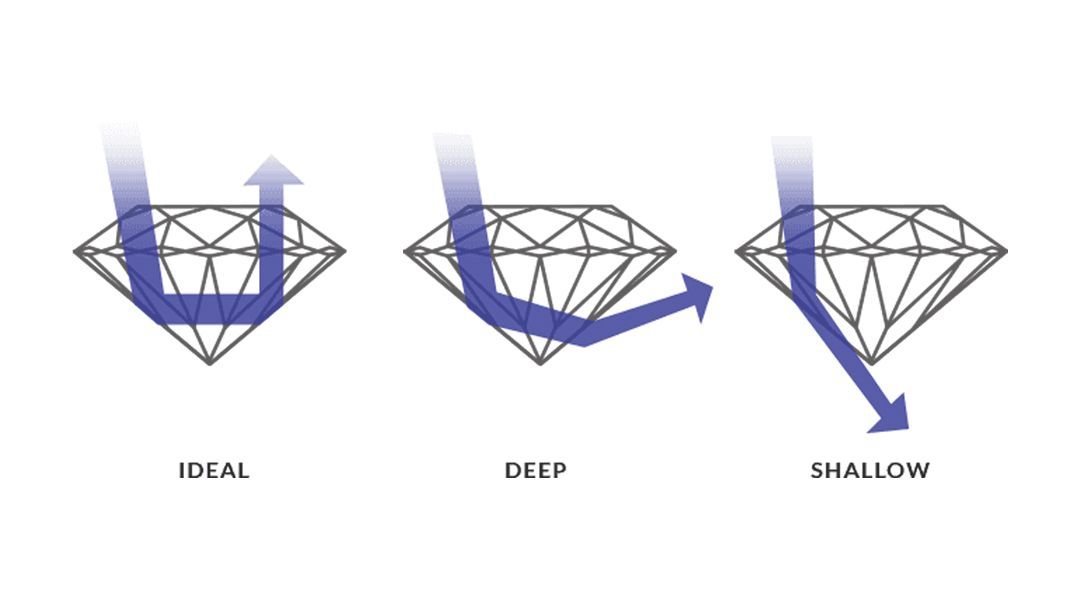THE FOUR C'S OF A DIAMOND

What is the Cut?
Of the 4Cs, cut is the most important characteristic because it has the greatest influence on a diamond's brilliance.
A diamond cut is a style or design guide used when shaping a diamond for polishing such as the brilliant cut. Cut does not refer to shape (pear, oval), but the symmetry, proportioning and polish of a diamond. The cut of a diamond greatly affects a diamond's brilliance; this means if it is cut poorly, it will be less luminous.
The better the cut grade, the more it will sparkle.

What is the Cut?
Of the 4Cs, cut is the most important characteristic because it has the greatest influence on a diamond's brilliance.
A diamond cut is a style or design guide used when shaping a diamond for polishing such as the brilliant cut. Cut does not refer to shape (pear, oval), but the symmetry, proportioning and polish of a diamond. The cut of a diamond greatly affects a diamond's brilliance; this means if it is cut poorly, it will be less luminous.
The better the cut grade, the more it will sparkle.
What is Clarity?
Cut refers not to a diamond's shape (e.g. round, oval, pear, etc.) but to a diamond's proportions, symmetry and polish. Clarity is the third most important characteristic because most imperfections cannot be seen unless under professional magnification.
Clarity refers to the tiny imperfections called inclusions. Diamonds with the least and smallest inclusions receive the highest clarity grades.
Maximize your budget with an eye-clean diamond (grades VVSI-SI1), which means it has no visible inclusions to the naked eye

What is Clarity?
Cut refers not to a diamond's shape (e.g. round, oval, pear, etc.) but to a diamond's proportions, symmetry and polish. Clarity is the third most important characteristic because most imperfections cannot be seen unless under professional magnification.
Clarity refers to the tiny imperfections called inclusions. Diamonds with the least and smallest inclusions receive the highest clarity grades.
Maximize your budget with an eye-clean diamond (grades VVSI-SI1), which means it has no visible inclusions to the naked eye


What is COLOR?
Diamond Color Actually Means Lack of Color.
The diamond color evaluation of most gem-quality diamonds is based on the absence of color. A chemically pure and structurally perfect diamond has no hue, like a drop of pure water, and consequently, a higher value.
Color is the second most important characteristic because the human eye detects sparkle first and color second. As a diamond's color grade improves, it's price increases. The color difference cannot be detected unless under professional magnification.
To maximize your budget, choose what's called a near-colorless diamond (grades G-H) because the naked eye will still not see traces of color for these grades.

What is COLOR?
Diamond Color Actually Means Lack of Color.
The diamond color evaluation of most gem-quality diamonds is based on the absence of color. A chemically pure and structurally perfect diamond has no hue, like a drop of pure water, and consequently, a higher value.
Color is the second most important characteristic because the human eye detects sparkle first and color second. As a diamond's color grade improves, it's price increases. The color difference cannot be detected unless under professional magnification.
To maximize your budget, choose what's called a near-colorless diamond (grades G-H) because the naked eye will still not see traces of color for these grades.
What is CARAT?
Diamond carat weight is the measurement of how much a diamond weighs. A metric “carat” is defined as 200 milligrams. Each carat can be subdivided into 100 'points.' This allows very precise measurements to the hundredth decimal place.
The most well-known and misunderstood characteristic of the 4Cs is Carat Weight. It actually refers to the diamond's weight, not its size. A diamond's cut impacts how large the Carat Weight will appear. Smaller carat weight diamonds will appear larger with higher cut grades.
Maximize your budget by buying a diamond that is slightly below your ideal carat weight.

What is CARAT?
Diamond carat weight is the measurement of how much a diamond weighs. A metric “carat” is defined as 200 milligrams. Each carat can be subdivided into 100 'points.' This allows very precise measurements to the hundredth decimal place.
The most well-known and misunderstood characteristic of the 4Cs is Carat Weight. It actually refers to the diamond's weight, not its size. A diamond's cut impacts how large the Carat Weight will appear. Smaller carat weight diamonds will appear larger with higher cut grades.
Maximize your budget by buying a diamond that is slightly below your ideal carat weight.



